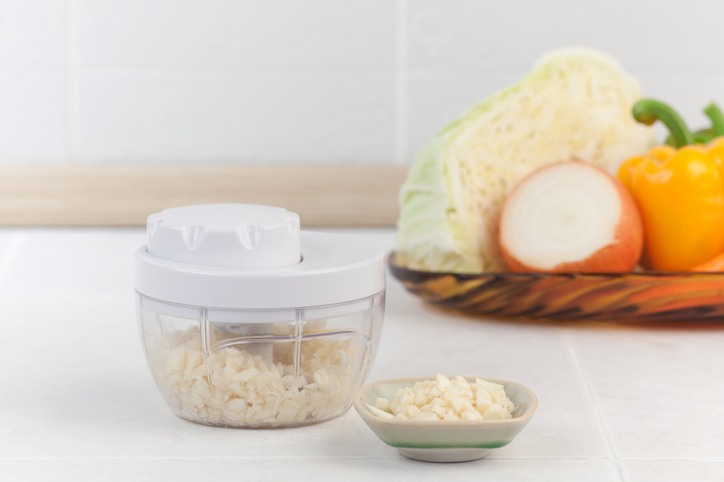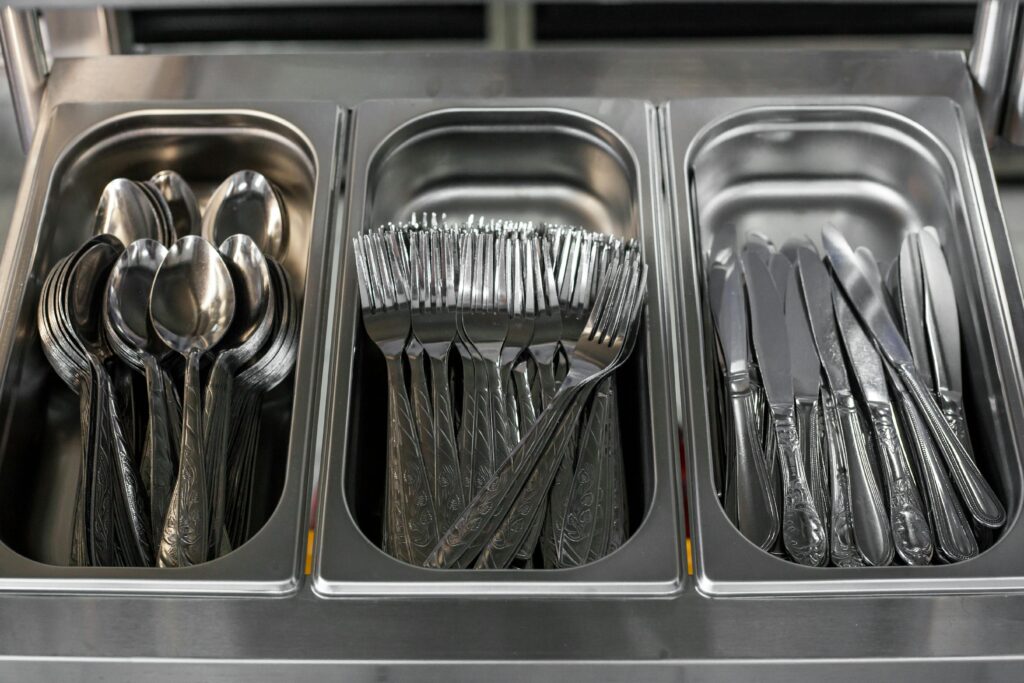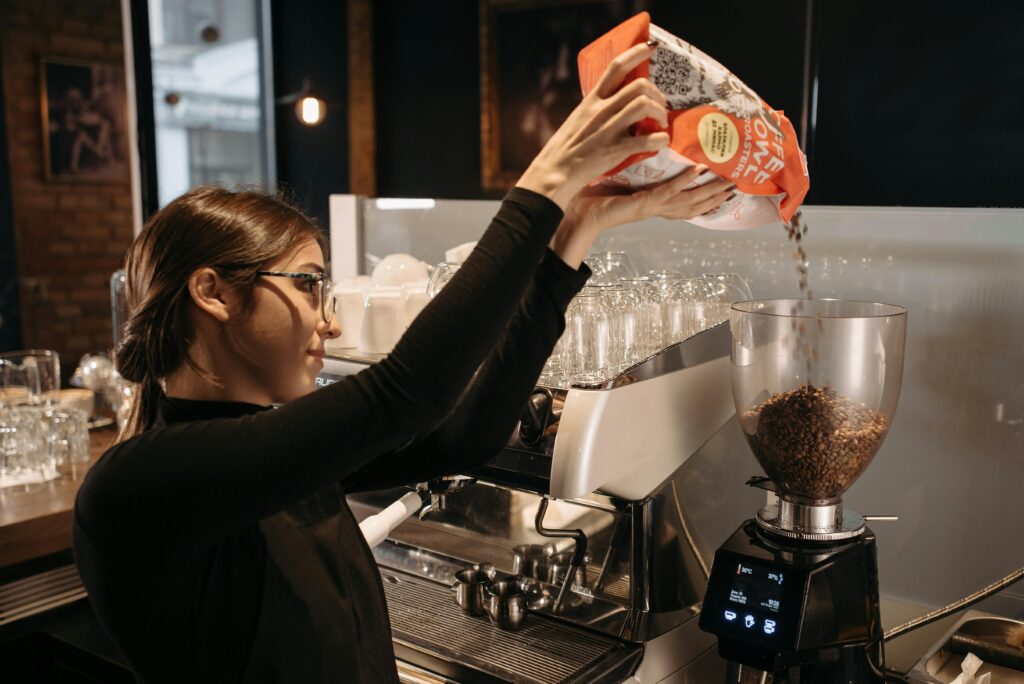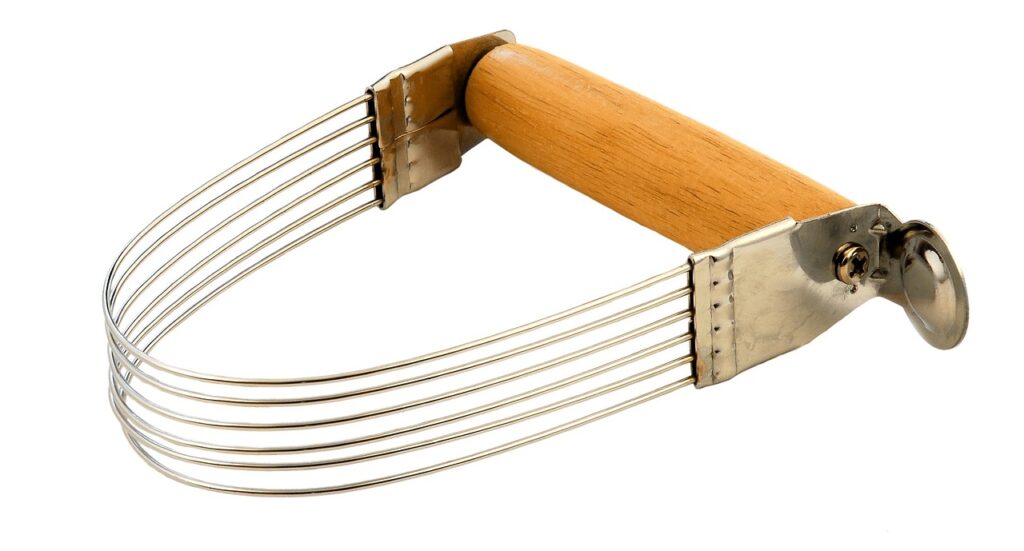Have you ever found yourself in the middle of a recipe only to realize your food processor is nowhere to be found? You’re not alone. Fortunately, your culinary journey doesn’t have to end there. From the humble mortar and pestle to the versatile immersion blender, there are at least 15 alternatives that can step in to save the day. Each tool comes with its unique set of advantages, whether it’s the simplicity of a box grater or the precision of a good old-fashioned knife.
Curious about how these alternatives stack up against the convenience of a food processor? Let’s explore how these substitutes not only fill the void but may also introduce new textures and techniques to your cooking repertoire.
Immersion Blender
Why not consider an immersion blender, a handy tool that easily blends and purees ingredients right in the container? If you’re seeking a compact and versatile appliance, immersion blenders are your go-to. Unlike bulky food processors, they’re easy to store and perfect for various tasks. From making smoothies to crafting creamy soups, these blenders excel in blending and pureeing directly in pots or bowls.
For efficient blending, choose a tall and narrow container. This setup ensures your immersion blender performs at its best, giving you smooth, well-blended results every time. You’ll appreciate the convenience and control it offers, allowing you to blend with precision without transferring contents from one container to another.
Whether you’re whipping up sauces or simply love the ease of making a quick puree, an immersion blender simplifies the process. Its design focuses on blending ingredients with ease, ensuring you achieve the perfect texture for your dishes. So, when you’re exploring alternatives to the food processor, remember the immersion blender – a powerful, yet easy-to-use tool that seamlessly integrates into your cooking routine.
Stand Mixer
Switching gears to the stand mixer, you’ll find it’s a powerhouse for mixing, kneading, and whipping needs. Its versatility is boosted by a range of attachments, from paddles to dough hooks, making it indispensable for various tasks.
Whether you’re making pasta or grinding meat, the optional attachments open up a whole new world of culinary possibilities.
Versatile Mixing Abilities
Stand mixers, with their versatile attachments like paddles, whisks, and dough hooks, excel at a variety of kitchen tasks from mixing and kneading to whipping cream and beating eggs. When you’re looking for a mixer that can truly do it all, the versatility of a stand mixer can’t be overstated. These attachments are specifically designed for different mixing needs, ensuring that whatever you’re making, you’ve got the right tool for the job.
Whether you’re preparing a cake batter, kneading bread dough, or whipping up a meringue, your stand mixer is up to the task. It’s a versatile assistant in your kitchen, providing a convenient and hands-free way to mix ingredients thoroughly, making your baking and cooking projects easier and more enjoyable.
Attachment Options
When you delve into the world of stand mixers, you’ll discover that their attachment options, such as food processors and meat grinders, significantly broaden their culinary applications. These versatile tools aren’t just for mixing and kneading dough anymore.
With specific attachments, your stand mixer can chop, slice, shred, and puree just as efficiently as a standalone food processor. They offer a space-saving, convenient solution for various food processing tasks, turning your stand mixer into a one-stop culinary center.
Whether you’re preparing large quantities of ingredients or looking for cost-effective alternatives to buying multiple appliances, these attachment options expand your stand mixer’s functionality, making it an invaluable ally in your kitchen adventures.
Manual Chopper
Let’s talk about the manual chopper, a tool that’s both easy to use and clean. You’ll appreciate its straightforward design, whether it’s the pull-string version or the electric model, making your chopping tasks less of a chore.
Plus, its simplicity means you won’t be spending ages cleaning it after every use, allowing you more time to enjoy your culinary creations.
Ease of Use
For those seeking a simple and efficient way to chop ingredients, manual choppers offer an easy-to-use solution that fits perfectly into any kitchen routine. Unlike a bulky food processor, manual choppers are designed with ease of use in mind. Here’s how they effortlessly integrate into your culinary tasks:
- Portability: Easily move them from one countertop to another without fuss.
- Minimal Storage: Tuck them away in a drawer or cabinet, freeing up valuable kitchen space.
- Versatile Designs: Whether it’s a pull chopper or a more straightforward slicer, there’s a style to suit your needs.
- Hands-On Control: You’re in charge of the texture, ensuring your food is chopped to perfection every time.
Manual choppers streamline the process, making food prep more enjoyable and less of a chore.
Cleaning Process
After exploring the ease of use manual choppers offer, it’s crucial to understand how to keep them clean and functional. Cleaning your manual chopper, an alternative to using a food processor, involves a few simple steps to ensure thorough cleaning and long-lasting use.
| Step | Description |
|---|---|
| Disassemble | Carefully take apart the chopper to access all parts. |
| Wash | Use warm, soapy water to clean the blades and container, ensuring no food residue remains. |
| Dry & Store | Dry all components before reassembling and store in a safe place. |
Use a small brush or toothpick for any stuck particles. This will keep your clean manual chopper in top condition, ready for your next culinary adventure.
Box Grater
A box grater, with its multiple sides and blades, offers a versatile solution for shredding or grating various ingredients, from cheese to vegetables, without needing a food processor. This handy kitchen gadget isn’t just for cheese; its multiple grating options make it a go-to tool for preparing ingredients for a wide range of dishes. Whether you’re looking to add a fine zest to a dish or need larger shreds for a salad, a box grater gets the job done with ease and precision.
Imagine you’re in the kitchen, and here’s what you can achieve with a box grater:
- Coarsely shredded carrots for a fresh, crunchy addition to your salad.
- Finely grated Parmesan to top off a steaming bowl of pasta.
- Zest of lemon to add a tangy twist to your baking.
- Sliced cucumbers for a quick, healthy snack.
Box graters aren’t only versatile tools for grating ingredients, but they also ensure consistent results, whether you’re shredding vegetables or zesting citrus fruits. Their sturdy design provides stability and safety, making your kitchen tasks smoother and more efficient. Plus, they’re compact and easy to store, proving to be an invaluable addition to your collection of kitchen essentials.
Mortar and Pestle
Diving into the timeless appeal of the mortar and pestle, you’ll discover its unmatched ability to enhance the flavors and textures of your ingredients through precise grinding. With this ancient tool, you have the ultimate control over the consistency of your ingredients, whether you’re grinding spices, crushing garlic, or creating flavorful pastes for your next culinary masterpiece. The friction generated between the pestle and the mortar is key to unlocking the aromatic oils and flavors hidden within your spices and herbs.
Choosing the right size mortar and pestle for your cooking needs ensures that you’re not just efficient but also effective in your grinding tasks. The beauty of using a mortar and pestle lies in its simplicity and the tactile connection it fosters with your food. Unlike electric food processors, this method retains more of the ingredients’ flavor and nutrition, making every dish more vibrant and nutritious.
Ideal for those who cherish the art of cooking, a mortar and pestle set allows you to infuse your dishes with freshly ground spices and handcrafted pastes, elevating your cooking to new heights. So, next time you’re in the kitchen, consider reaching for this age-old tool to truly unlock the essence of your ingredients.
Precision Knives
In the realm of kitchen tools, precision knives stand out for their unmatched ability to offer control and accuracy, ensuring your ingredients are perfectly sliced, diced, and chopped. As you embark on your culinary adventures, embracing the power of a sharp chef’s knife or a nimble paring knife can transform your cooking experience.
Here’s why precision knives are essential in your kitchen arsenal:
- Chef’s Knife: The quintessential tool for any cook, its broad and sharp blade is ideal for a variety of chopping tasks, from mincing garlic to slicing meats.
- Paring Knife: Perfect for smaller, more intricate tasks like peeling fruits or deveining shrimp, its precision is unmatched.
- Cutting Techniques: Mastering different cutting techniques, such as julienne or chiffonade, allows you to prep ingredients with professional efficiency and aesthetic appeal.
- Sharp Knife Blades: Keeping your knives sharp ensures that you’re cutting safely and effectively, reducing the risk of accidents caused by dull blades needing excessive force.
Embracing these tools and skills in your kitchen not only elevates your cooking but also adds a layer of joy to the preparation process. Precision knives, with their versatility and efficiency, prove to be indispensable allies in your culinary creations.
Fork and Spoon Technique
Moving on from precision knives, let’s talk about the fork and spoon technique, a basic yet practical approach to food preparation. This method lets you mash and mix softer ingredients effectively, although it’s not your go-to for tasks needing fine chopping or blending.
It’s a straightforward technique, but knowing its practical uses can save you time and deliver satisfactory results for certain tasks.
Basic Technique Overview
For mashing avocados, bananas, or boiled potatoes efficiently, the Fork and Spoon Method offers a straightforward, manual alternative to the food processor. This technique involves:
- Selecting Your Target: Choose softer ingredients ripe for mashing.
- Preparation: Cut the ingredients into smaller, manageable pieces if necessary.
- Using a Fork: Hold the fork in one hand to pierce and break down the ingredient into smaller chunks.
- Incorporating the Spoon: With the spoon in your other hand, scoop and mash the chunks until you achieve the desired texture.
This manual approach might take more time compared to a food processor, but it’s perfect for when you’re working with softer ingredients and need a simple solution without specialized tools.
Practical Uses
Exploring the practical uses of the fork and spoon technique, you’ll discover how this method can simplify your kitchen tasks, especially when working with soft ingredients. This approach is particularly effective for breaking down and mashing items like avocados or boiled potatoes.
While it might require more manual labor compared to using a hand mixer, it avoids the need for specialized kitchen tools. The fork and spoon method is time-consuming but yields satisfactory results for tasks that don’t demand you to finely chop or puree ingredients.
It’s not suitable for all food processing tasks but comes in handy for simple recipes. This manual, hands-on method allows you to mash, mix, or break down ingredients to achieve desired textures, offering a straightforward alternative to the food processor.
Handheld Blender
Handheld blenders, compact and easy to store, offer a versatile solution for blending, pureeing, and some chopping tasks right in your container. They’re a dream for small kitchen spaces, providing the flexibility you need without the bulk of traditional appliances. When you use an immersion blender, you can quickly whip up smoothies, soups, and sauces directly in their cooking or serving containers, making cleanup a breeze.
Imagine the possibilities:
- Creating Silky Smooth Soups – With the blender blades directly immersed, you can achieve a smooth consistency without transferring hot liquids between containers.
- Whipping Up Homemade Mayonnaise – A quick pulse of the blender can emulsify ingredients for fresh condiments in minutes.
- Crafting Creamy Smoothies – Blend fruits, vegetables, and liquids in a tall container for a quick, nutritious breakfast.
- Making Chunky Salsas – By controlling the texture, you can pulse the blender to keep your salsa as chunky or smooth as you like.
Potato Masher
After considering the versatility of handheld blenders, let’s look at the potato masher, another kitchen essential that simplifies the task of achieving a smooth or textured mash. This manual tool, commonly found in households, is your go-to for creating dishes like creamy mashed potatoes, guacamole, or fruit coulis without the need for a food processor. It’s a straightforward alternative that offers a smooth consistency for purees and sauces by breaking down ingredients until they’re soft and creamy.
Using a potato masher doesn’t just save you money; it’s a practical solution for manual food processing tasks. Whether you’re aiming for a velvety smooth texture or a slightly chunky mash, this tool puts you in control of the final product. It’s incredibly versatile and easy to use, making it ideal for recipes that call for mashed or pureed ingredients.
Coffee Grinder
When you’re looking at grinding dry ingredients or preparing spice powders, a coffee grinder is your go-to tool. It’s perfect for small batches, allowing you to achieve the exact texture you need for your cooking and baking. Plus, the natural oils released during grinding will undoubtedly elevate the flavors and aromas in your dishes.
Grinding Dry Ingredients
For grinding dry ingredients like spices, nuts, and seeds, a coffee grinder can be a highly efficient and quick alternative to using a food processor. When you’re dealing with small quantities, the compact size of a coffee grinder becomes particularly advantageous. Moreover, grinding dry ingredients in a coffee grinder helps release their essential oils and flavors, leading to better-tasting results.
Imagine the possibilities:
- Transforming whole spices into vibrant, aromatic powders.
- Quickly grinding nuts for baking or garnishing.
- Creating your own freshly ground seed mixes for healthful benefits.
- Preparing homemade nut flours with ease and precision.
Coffee grinders aren’t just for coffee beans; they’re a versatile tool in your culinary arsenal, making them a must-have for those who cherish freshness and flavor in their cooking.
Spice Powder Preparation
Having explored the versatility of coffee grinders for dry ingredients, let’s focus on mastering spice powder preparation to elevate your culinary creations.
A coffee grinder can efficiently grind spices into a fine powder, perfect for seasoning and cooking. It’s compact and easy to use, making it ideal for small spice batches. When you grind spices, you release their flavors and aromas, significantly enhancing your dishes.
Ensure the grinder is clean and dry before use to prevent flavor contamination. Moreover, it’s wise to use a dedicated coffee grinder for spices to avoid flavor transfer from coffee beans. This simple practice will ensure your spices retain their pure, vibrant flavors, ready to transform any meal.
Electric Whisk
An electric whisk can significantly streamline your kitchen tasks, effortlessly blending ingredients to perfection. It’s not just about mixing; it’s about creating culinary magic with less effort and more efficiency. Imagine you’re in your kitchen, faced with a recipe that calls for perfectly whipped cream or smooth, airy batter. With an electric whisk in hand, you’re not just preparing food; you’re crafting textures and flavors that manual methods can hardly match.
When you use an electric whisk, you:
- Efficiently mix ingredients, ensuring that everything from cake batters to salad dressings is combined uniformly without the need for tiresome stirring.
- Master the art of whisking eggs, achieving the perfect consistency for omelets, meringues, or even simple scrambled eggs with ease.
- Create smooth textures in sauces, creams, and soups that elevate the dining experience from ordinary to extraordinary.
- Save time in the kitchen, allowing you to focus on other aspects of meal preparation or simply enjoy those extra moments with family and friends.
With its versatility, ease of use, and the ability to transform simple ingredients into culinary masterpieces, an electric whisk is a must-have tool for anyone looking to enhance their cooking and baking endeavors.
Dough Blender
When tackling the art of pastry making, a dough blender becomes your indispensable ally, effortlessly incorporating butter into flour for that perfect, flaky texture. This handheld tool, boasting curved stainless steel blades, is designed to cut through butter or shortening with precision. It’s not just about mixing; it’s about creating a crumbly texture that’s essential for tender and flaky baked goods like pie crusts, biscuits, or scones.
The ergonomic handle of the dough blender ensures you’ve got a comfortable grip and control over the blending process. This is crucial for preventing the overmixing that can lead to tough pastries. Moreover, using this tool significantly reduces the risk of the fats in your dough melting, a common mishap that can ruin the delicate balance needed for that sought-after flakiness.
Besides mixing fats and dry ingredients, a dough blender is versatile enough to blend in other elements like sugar, spices, or nuts, ensuring even distribution without overworking the mixture. It’s a simple yet effective way to achieve consistency and texture in your pastry dough, making the dough blender an essential tool in your baking arsenal.
Cheese Grater
Grating cheese manually with a cheese grater offers unparalleled control over the texture and size of your ingredients, enhancing the overall quality of your dishes. Unlike a food processor, a cheese grater allows you to feel the resistance of the cheese, vegetables, or nuts as you grate, giving you a direct connection to the food you’re preparing. It’s not just about grating cheese; your cheese grater is a versatile tool that can tackle a variety of kitchen tasks.
Imagine:
- The satisfying scrape of the grater against a block of cheddar, yielding perfect shreds for your tacos.
- Carrots and zucchini transforming into delicate ribbons for a vibrant, healthy slaw.
- The aromatic dust of chocolate and nuts, finely grated to top off a homemade cake.
- The ease of switching between coarse and fine textures by simply rotating your box grater.
Whether you’re using a handheld grater for quick tasks or a box grater for its stability and multiple grating options, you’ll appreciate the precision it brings to your cooking. Yes, it might be more labor-intensive than pushing a button on a food processor, but the tactile experience and control you gain are worth the extra effort.
Rolling Pin and Bag
For crushing nuts, cookies, or crackers without a food processor, you can turn to the simple yet effective method of using a rolling pin and a plastic bag. This cost-effective alternative doesn’t just save you money; it also introduces a safer way to handle manual food preparation, ensuring you won’t cut yourself as you might with sharper kitchen tools.
All it takes is a bit more time and effort on your part compared to the quick whirl of a food processor. You’ll find yourself engaging more physically with the ingredients, which can be both satisfying and a bit of a workout. Yes, cleanup might pose a bit of a challenge, especially if you’re dealing with sticky substances. However, the convenience of not having to wash multiple parts of a food processor or deal with its setup and storage is a significant plus.
The rolling pin and bag technique isn’t just about crushing nuts, cookies, or crackers. It’s about embracing the versatility and practicality of manual food preparation, offering you a way to bring out your culinary creativity even when specialized equipment isn’t an option.
Soft Cooking Method
Moving from the physicality of using a rolling pin and bag, let’s explore the soft cooking method, a technique that simplifies pureeing by softening ingredients through cooking. This approach isn’t only about making your ingredients squishy but also about using heat to break them down, making manual processing a breeze. It’s a fantastic alternative for pureeing without needing a food processor.
Consider these steps to visualize the process:
- Selecting Ingredients: Choose fruits, vegetables, or legumes that soften nicely when cooked. Think potatoes, carrots, or apples.
- Cooking Softly: Simmer your chosen ingredients in water, or steam them until they’re tender enough to mash with a fork.
- Flavor Enhancement: During the soft cooking process, you’ve got the chance to add spices and condiments. This step infuses your ingredients with deeper flavors, elevating the end result.
- Manual Processing: Once cooked and flavored, use a fork or potato masher to puree your ingredients. This part of the process requires a bit of elbow grease but is significantly aided by the softness of the cooked items.
Though soft cooking is time-consuming, it’s a practical and flavorful alternative for pureeing without the high-tech gadgets.
Conclusion
In conclusion, you don’t need a food processor to tackle your kitchen tasks. Whether you’re blending with an immersion blender, mixing with a stand mixer, or getting back to basics with a mortar and pestle, there’s a tool for every job.
From grating cheese to mashing ingredients softly, you’ve got plenty of options. So, choose the one that best suits your needs and dive into your culinary adventures. Remember, it’s all about making cooking enjoyable and efficient for you.










